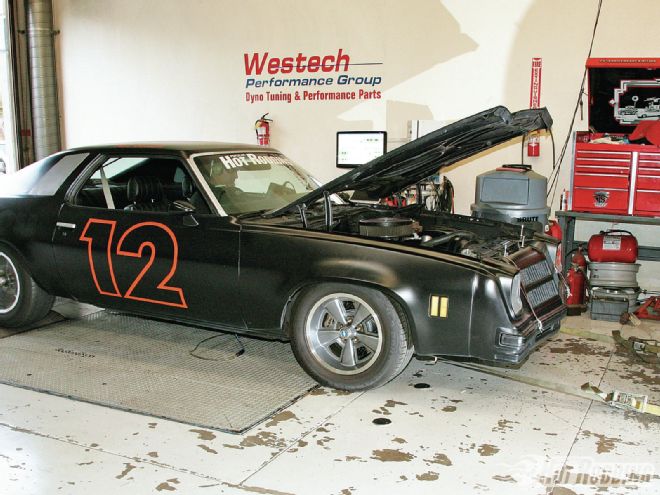
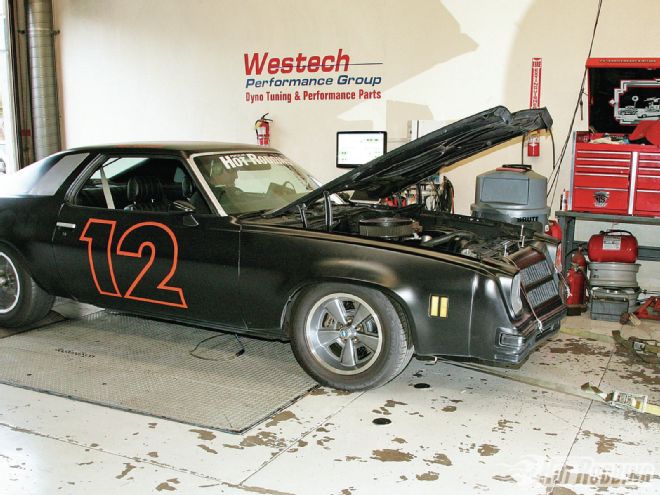 Although our Dart SHP-based 427-cube small-block cranked 627 hp on the engine dyno, it seemed a little soft installed in our NASCAR-inspired Project Laguna. We hit the SuperFlow chassis dyno to find the missing power …
Although our Dart SHP-based 427-cube small-block cranked 627 hp on the engine dyno, it seemed a little soft installed in our NASCAR-inspired Project Laguna. We hit the SuperFlow chassis dyno to find the missing power …
Our supersized 427-cube small-block (See “The Anti LS,” PHR Oct. and Nov. ’11) seemed just right for our ’75 Chevelle Laguna project car—big cubes and big power in a traditional small-block package. The amply proportioned Chevy NASCAR tribute just begged for the big torque and power that the large Dart SHP based small-block could deliver. With a dyno-tested 627 hp and 561 lb-ft of torque on hand, this engine combination had the muscle to make our Chevrolet fly. Though the major infusion of cubic inches had us anxious to hit the streets, driving it just didn’t seem to meet the expectations. It just failed to hit as hard as the raw engine dyno numbers would have suggested. We seemed short on power, and our mission was to find it.
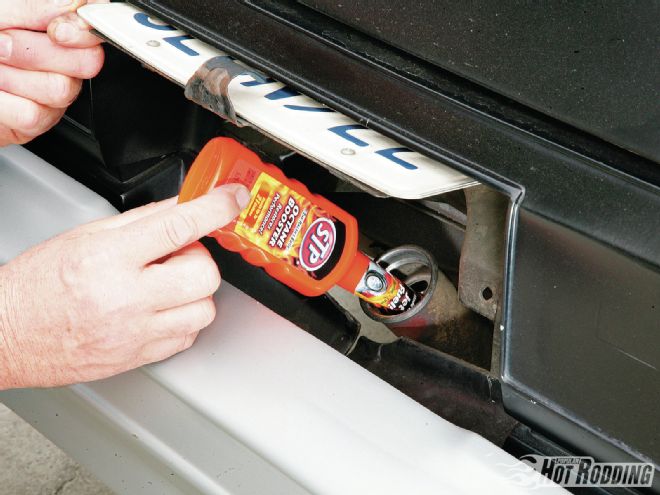 Although we hadn’t heard detonation over the aggressive exhaust in the Laguna, as extra insurance we ran a couple of bottles of STP Jet Fuel Octane Booster in the tank. This turned out to be the right protective move, as we would go on to discover both a lean mixture and too much total ignition timing—both situations later rectified. The important thing is to not use up the motor when you’re tuning, and an octane booster like STP can help a lot.
Although we hadn’t heard detonation over the aggressive exhaust in the Laguna, as extra insurance we ran a couple of bottles of STP Jet Fuel Octane Booster in the tank. This turned out to be the right protective move, as we would go on to discover both a lean mixture and too much total ignition timing—both situations later rectified. The important thing is to not use up the motor when you’re tuning, and an octane booster like STP can help a lot.
To get a handle on just where those 600-plus horsepower were hiding, we brought the Laguna to Westech Performance Group for a power tuning session on their SuperFlow Chassis dyno—which has the advantage of allowing both acceleration pulls and steady-state tuning via the unit’s eddy current design. We knew from the engine dyno numbers that the big-cube solid-roller combination was capable of healthy numbers, but something seemed to have gotten lost in the process of installing the engine into Project Laguna. Figuring the missing power could be found in the tune, step one was welding a bung for a wide-band O2 sensor into the header collector for a close look at the running air/fuel ratio. Westech’s Ernie Mena quickly had the bung welded in, and our Chevelle strapped down for a baseline look. Step two was pouring in a few bottles of STP Jet Fuel Octane Booster, which is a good idea any time you’re tuning on the chassis dyno; this safety measure prevents engine damage should there be any unknown problems with ignition timing or a lean fuel condition.
After a short warm-up, the throttle was wooded for a pull, however, Mena cut out early at only 4,000 rpm, noting the air/fuel ratio running dangerously lean at nearly 17:1. Thank goodness we had the STP in the tank, or we could’ve melted a piston or beat up some bearings. Mena also noticed that the tip-in mixture was spiking lean as he rolled into the throttle. Clearly there was some serious carb tuning needed to satisfy our powerful small-block’s hunger for fuel.
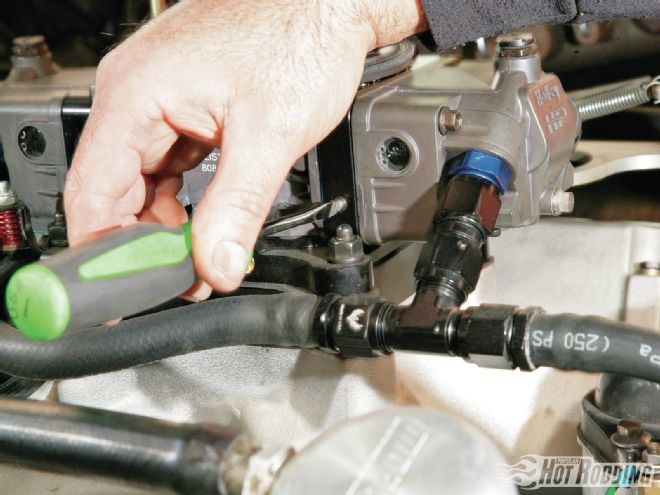 Holley’s new 850 Ultra HP carb is a gem, and our initial tuning included dialing in the four-corner idle circuits and the idle speed screws. The idle mixture setting can affect the tune right up the rpm range, so this should be one of the first carb tune settings made.
Holley’s new 850 Ultra HP carb is a gem, and our initial tuning included dialing in the four-corner idle circuits and the idle speed screws. The idle mixture setting can affect the tune right up the rpm range, so this should be one of the first carb tune settings made.
Opening the brand-new Holley 850 Ultra HP carb, we found the jetting at 84/84 front to rear. As an initial step, the rear jets were stepped up to 89s, then later on to 94s when that proved not enough. To aid in the tip-in enrichment, the secondary power valve was swapped from a 4.0 to an 8.5 unit to bring the power valve enrichment circuit into play earlier. Since the part-throttle mixture registered a reasonable cruise air/fuel ratio in the low 13:1 range, the primary side of the carb was left unchanged at this point. Surprisingly, the large change in secondary jetting had a relatively small effect on the fuel delivery, with the numbers still showing the big small-block thirsty for fuel. Rather than upsize the already rather large jetting, we next moved to the high-speed air bleeds, looking to increase the signal to the main metering circuit.
The air bleeds were swapped from 34s to 30s at the rear barrels, and we only found marginal enrichment, however, it was safe enough to let the engine rev out to 6,500 rpm, where we found 499 hp at the tire. The big-inch small-block was clearly coming to life. Tuning was definitely delivering progress, and we had plenty more room to go. Turning our attention to timing, we noted the 427 was running a full 40 degrees of total advance. Though there was no trace of detonation (thanks STP!), Mena suggested that it may be more than optimal. Dialing back the timing via a timing loop determined that 37 degrees was optimal, resulting in a power gain to 510 rear-wheel horsepower.
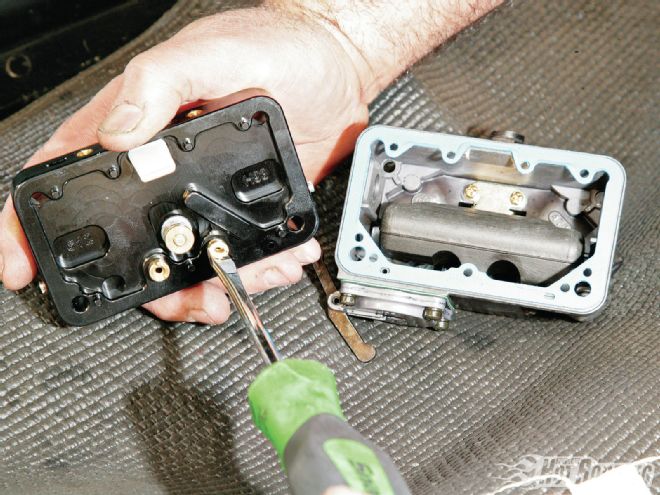 Our powerful 427ci small-block definitely had an appetite for fuel, and the first pull resulted in an aborted run due to a dangerously lean mixture. Step one was a significant move in the secondary jetting, adding five jet sizes from 84s to 89s.
Our powerful 427ci small-block definitely had an appetite for fuel, and the first pull resulted in an aborted run due to a dangerously lean mixture. Step one was a significant move in the secondary jetting, adding five jet sizes from 84s to 89s.
Though the power was coming in strong, the ratio was still borderline lean. We went back to the carb, looking to enrich the mixture to a safer overall ratio, while retaining the engine’s newfound power. The tuning steps to follow were all aimed at delivering more fuel, starting with upping the primary enrichment with a change from 84 to 89 jets, and then to 28s on the high-speed air bleeds all around. Power remained at our previous peak of 510 hp, but the air/fuel ratio was only mildly affected, still recording over 13:1. Seeking to put the ratio in a safer range, Mena made a more significant change, reducing the high-speed bleeds in the Holley 850 Ultra HP to 22s all around. This tuning combination brought the numbers into the zone, showing an air/fuel ratio of 12.9:1 at peak horsepower, while the power number remained at our previously recorded best of 510 hp.
With 510 hp churned at the wheels, the Laguna was definitely making the sauce. The chassis dyno tuning session clearly brought out the engine’s missing potential, and put the fuel delivery into a safe zone. Any small-block that puts out over 500 hp at the wheels is a serious piece. The chassis dyno tuning session let our engine’s power potential come to life, and the safe tuning zone ensures it will be a long life indeed.